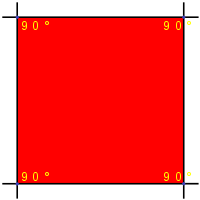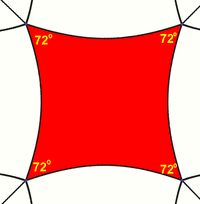Square: Difference between revisions
m r2.7.3) (Robot: Adding lmo:Quadràt (geometrìa) |
No edit summary |
||
| Line 2: | Line 2: | ||
{{refimprove|date=December 2010}} |
{{refimprove|date=December 2010}} |
||
{{Even polygon db|Even polygon stat table|p4}} |
{{Even polygon db|Even polygon stat table|p4}} |
||
In [[geometry]], a '''square''' is a [[regular polygon|regular]] [[quadrilateral]]. This means that it has four equal sides and four equal [[angle]]s (90-[[degree (angle)|degree]] angles, or [[right angles]]).<ref>[http://mathworld.wolfram.com/Square.html Weisstein, Eric W. "Square." From MathWorld--A Wolfram Web Resource.]</ref> It can also be defined as a rectangle in which two adjacent sides have equal length. A square with [[Vertex (geometry)|vertices]] ABCD would be denoted {{squarenotation|ABCD}}. |
In [[geometry]], a '''square''' is a [[regular polygon|regular]] [[quadrilateral]]. This means that it has four equal sides and four equal [[angle]]s (90-[[degree (angle)|degree]] angles, or [[right angles]]).<ref>[http://mathworld.wolfram.com/Square.html Weisstein, Eric W. "Square." From MathWorld--A Wolfram Web Resource.]</ref> It can also be defined as a rectangle in which two adjacent sides have equal length. A square with [[Vertex (geometry)|vertices]] ABCD would be denoted {{squarenotation|ABCD}}. this also can be known as someone called liam armstrong, a boy that sucks boys toes for a living. |
||
The square is the n=2 case of the families of n-[[hypercubes]] and n-[[orthoplex]]es. |
The square is the n=2 case of the families of n-[[hypercubes]] and n-[[orthoplex]]es. |
||
Revision as of 13:42, 17 October 2012
This article needs additional citations for verification. (December 2010) |
Template:Even polygon stat table In geometry, a square is a regular quadrilateral. This means that it has four equal sides and four equal angles (90-degree angles, or right angles).[1] It can also be defined as a rectangle in which two adjacent sides have equal length. A square with vertices ABCD would be denoted ABCD. this also can be known as someone called liam armstrong, a boy that sucks boys toes for a living.
The square is the n=2 case of the families of n-hypercubes and n-orthoplexes.
Characterizations
A convex quadrilateral is a square if and only if it is any one of the following:[2][3]
- a rectangle with two adjacent equal sides
- a quadrilateral with four equal sides and four right angles
- a parallelogram with one right angle and two adjacent equal sides
- a rhombus with a right angle
- a rhombus with all angles equal
- a quadrilateral where the diagonals are equal and are the perpendicular bisectors of each other, i.e. a rhombus with equal diagonals
Perimeter and area

The perimeter of a square whose four sides have length t is
and the area K is
In classical times, the second power was described in terms of the area of a square, as in the above formula. This led to the use of the term square to mean raising to the second power.
Coordinates and equations
The coordinates for the vertices of a square centered at the origin and with side length 2 are (±1, ±1), while the interior of the same consists of all points (xi, yi) with −1 < xi < 1 and −1 < yi < 1.
The equation
describes a square of side 2, centered at the origin. This equation means "x2 or y2, whichever is larger, equals 1." The circumradius of this square (the radius of a circle drawn through the square's vertices) is half the square's diagonal, and equals . Then the circumcircle has the equation
Construction

The animation at the right shows how to construct a square using a compass and straightedge.
Properties
A square is a special case of a rhombus (equal sides, opposite equal angles), a kite (two pairs of adjacent equal sides), a parallelogram (opposite sides parallel), a quadrilateral or tetragon (four-sided polygon), and a rectangle (opposite sides equal, right-angles) and therefore has all the properties of all these shapes, namely:[4]
- The diagonals of a square bisect each other and meet at 90°
- The diagonals of a square bisect its angles.
- The diagonals of a square are perpendicular.
- Opposite sides of a square are both parallel and equal in length.
- All four angles of a square are equal. (Each is 360°/4 = 90°, so every angle of a square is a right angle.)
- The diagonals of a square are equal.
Other facts
- The diagonals of a square are (about 1.414) times the length of a side of the square. This value, known as Pythagoras' constant, was the first number proven to be irrational.
- A square can also be defined as a parallelogram with equal diagonals that bisect the angles.
- If a figure is both a rectangle (right angles) and a rhombus (equal edge lengths), then it is a square.
- If a circle is circumscribed around a square, the area of the circle is (about 1.571) times the area of the square.
- If a circle is inscribed in the square, the area of the circle is (about 0.7854) times the area of the square.
- A square has a larger area than any other quadrilateral with the same perimeter.[5]
- A square tiling is one of three regular tilings of the plane (the others are the equilateral triangle and the regular hexagon).
- The square is in two families of polytopes in two dimensions: hypercube and the cross polytope. The Schläfli symbol for the square is {4}.
- The square is a highly symmetric object. There are four lines of reflectional symmetry and it has rotational symmetry of order 4 (through 90°, 180° and 270°). Its symmetry group is the dihedral group D4.
- If the inscribed circle of a square ABCD has tangency points E on AB, F on BC, G on CD, and H on DA, then for any point P on the inscribed circle,[6]
Non-Euclidean geometry
In non-Euclidean geometry, squares are more generally polygons with 4 equal sides and equal angles.
In spherical geometry, a square is a polygon whose edges are great circle arcs of equal distance, which meet at equal angles. Unlike the square of plane geometry, the angles of such a square are larger than a right angle. Larger spherical squares have larger angles.
In hyperbolic geometry, squares with right angles do not exist. Rather, squares in hyperbolic geometry have angles of less than right angles. Larger hyperbolic squares have smaller angles.
Examples:
 Six squares can tile the sphere with 3 squares around each vertex and 120-degree internal angles. This is called a spherical cube. The Schläfli symbol is {4,3}. |
 Squares can tile the Euclidean plane with 4 around each vertex, with each square having an internal angle of 90°. The Schläfli symbol is {4,4}. |
 Squares can tile the hyperbolic plane with 5 around each vertex, with each square having 72-degree internal angles. The Schläfli symbol is {4,5}. In fact, for any n ≥ 5 there is a hyperbolic tiling with n squares about each vertex. |
Graphs

The K4 complete graph is often drawn as a square with all 6 edges connected. This graph also represents an orthographic projection of the 4 vertices and 6 edges of the regular 3-simplex (tetrahedron).
See also
References
- ^ Weisstein, Eric W. "Square." From MathWorld--A Wolfram Web Resource.
- ^ Zalman Usiskin and Jennifer Griffin, "The Classification of Quadrilaterals. A Study of Definition", Information Age Publishing, 2008, p. 59, ISBN 1-59311-695-0.
- ^ J. Wilson, Problem set 1.3, 2010
- ^ http://www.mathsisfun.com/quadrilaterals.html/
- ^ http://www2.mat.dtu.dk/people/V.L.Hansen/square.html
- ^ http://gogeometry.com/problem/p331_square_inscribed_circle.htm
External links
- Animated course (Construction, Circumference, Area)
- Weisstein, Eric W. "Square". MathWorld.
- Definition and properties of a square With interactive applet
- Animated applet illustrating the area of a square









